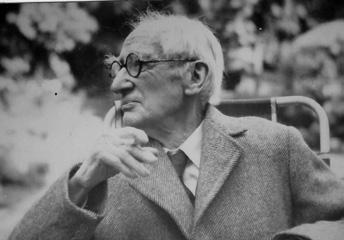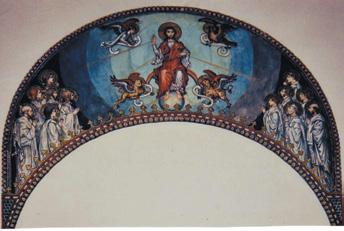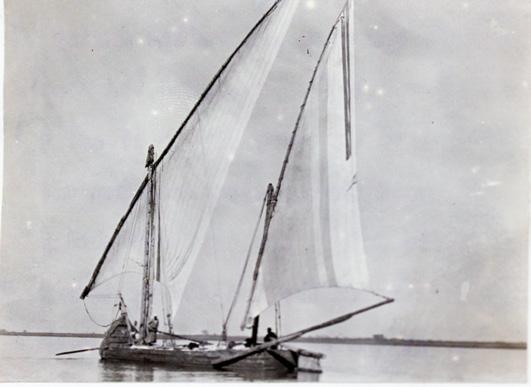
6 minute read
Cathedral History: Storms of Controversy – The Early Mosaics by Patrick Rogers 14 Cathedral History in Pictures: ‘Meals on Wheels’ and
stalls. Hutton therefore formed a committee of five and drew up a petition to the new Cardinal, to be signed by leaders of the world of art and architecture, urging Hinsley to stop the work on the mosaics and form a committee of experts to advise him. A preliminary letter (which Hinsley ignored) was followed in August 1935 by the petition signed by the Presidents of the Royal Academy and RIBA, the Directors of the National Gallery, Tate Gallery, Victoria and Albert Museum and many more.
Edward Hutton, aged 92, in 1967.
This time Hinsley responded. It is here that the Hutton papers are the most revealing, for they include an effusive handwritten letter from Hinsley of 4 September 1935 agreeing strongly that a commission of experts should be set up and asking Hutton to convey to those signing the petition the Cardinal’s heartfelt thanks for enabling ‘me to take up a firm position in this very important question. There can be no doubt that the Cathedral cannot be allowed to be the happy hunting ground of amateur experimentalists’. Hinsley followed this up with a meeting with Hutton and another member of his committee on 23 September, at which Hutton repeated his demands. It is clear from the Cardinal’s letters and notes that he had decided that only money specifically so dedicated should be used for decoration and that other available income should go to Catholic schools. But to be so frank with Hutton was a mistake which was to have repercussions.
At the end of October 1935 Hinsley received another letter from Hutton calling for the mosaic work to be stopped and a committee of experts set up, ‘the names for which were submitted to your Grace at your request’. Hutton warned that ‘the pressure for public expression in this matter is so strong and widespread that unauthorised publication in some form or another might appear at any time’. On 30 November, in the belief that the contract with Pownall was merely verbal and from year to year, Hinsley suspended work on the mosaics, to the dismay of the former, who claimed he had a contract for another three years. Shortly before 10pm on 2 December, Hinsley’s secretary telephoned Hutton with the decision. Hutton records in his notes that (as suspected) he immediately telephoned the press revealing details not only of the petition and of those who had signed it but also of the Cardinal’s appreciative response. Next day it was all over the newspapers.
A fortnight later Hinsley issued a statement that the petition had been published without his knowledge or consent. But at the same time the press reported that Pownall’s mosaic designs and the school of mosaics had been abandoned. Hutton remained in contact with Hinsley and met with the Cathedral’s solicitors regarding the terms of the contract with

Gilbert Pownall’s 1931 design for the Cathedral sanctuary arch mosaic.
Pownall who, after initially being sent just £100 in compensation, secured £2,000 in July 1936 after taking steps to sue for breach of contract, a charge which Hinsley was in no position to challenge in open court. It was also Hutton who, soon afterwards, provided Hinsley with the names of three Catholic laymen for the new art advisory committee. The names were accepted and the appointments made in October. Hutton had not nominated himself, but was nevertheless put out at not being invited. He finally became a member in 1938. Meanwhile, Pownall’s partfinished apse mosaic was taken down and only the 1939-45 War saved the sanctuary arch. In 1940 a Cosmatesque marble pavement, modelled on that in the Cappella Palatina in Palermo, was unveiled in St Paul’s Chapel in the Cathedral. It was designed by Edward Hutton – and Cardinal Hinsley liked it.

Gilbert Pownall’s model for the Cathedral apse mosaic.
Thieves, Tombs and Turkey
Fr John Scott
My great-great-great uncles Eli and John continue their voyage on the Nile and report home in letters to Leeds:
In a Boat on the Nile. Tuesday 9 December 1862.
Dear Father and Mother,
My last letter was written in Cairo immediately before commencing the voyage up the Nile. Now we are fairly launched on this noble River and have been so for a week. We took to our boat and sailed from Cairo a week ago today at 4 o’clock in the afternoon. We had the pyramids in full view for some distance and found some interest in the contemplation of these wonderful structures. They were, however, at a considerable distance from us and their magnitude was therefore somewhat subdued.
The River and its associations taken together afford us a large amount of interest and pleasure. There is some degree of monotony about it, but this does not become in any wise wearisome. The climate is sunny, warm (except in the early morning and in the evening when it is somewhat cold) and invigorating. The banks of the river are in some places sandy and desert but mostly covered with doura, which may be styled Egyptian corn, and palm trees. During the day everything is brilliantly lighted by an unclouded sun and in the evening by the silvery light of the moon (which is now fortunately only just past full).
We rise in the morning between 6 and 7 when we have coffee, buffalo’s milk and bread with butter made from the milk aforesaid. Then breakfast (which consists of sundry courses of meat ending with dessert) is served at 11. Dinner comes on at 5 o’clock in the evening. This may be described as an expansion of the breakfast. Our time is variously employed sometimes walking along the banks of the river seeking employment for our guns, sometimes reading, sometimes conversing. Thus day after day passes in a very agreeable manner. With respect to health, this mode of life seems in every respect adapted to promote it, and we may be said to be in first class condition as we are blessed with good appetite, good digestion, good assimilation, and as a consequence good bodily powers and good spirits. You will think after this description that it is all very very good.
Our boat goes well with sail when there is a favourable wind, and when there is not the sailors drag us along by means of a rope in like manner as the horses drag the boats along the canals in England. At intervals

Our boat on the Nile
we pass by a village built of bricks dried in the sun so that the houses look like mud heaps.
It is interesting to note the habits of the inhabitants, as in many things they appear in striking contrast to those of our own countrymen. Their civilization appears to be very limited.
The 5th and 6th of December were remembered by us as notable days in your history, and in spirit we wished you many happy returns of these days and much prosperity and peace. We should be glad to hear something of you if we had opportunity. You will, I have no doubt, sent us a letter or two to Cairo (to the Post Office) while we are going and returning on the Nile, so that we may hear of you when we return. In one sense we seem to be almost out of the World. Here newspapers are a thing unknown, i.e. since we left Cairo,

An ostrich farm at Heliopolis










